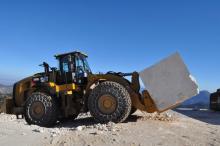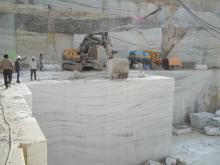
A 100% Caterpillar loading and hauling fleet is proving a powerful ally for Turkish family-owned firm Bej Mermer (Marble), as Guy Woodford saw first-hand.
Watching the operator of a Cat 980L BH (block handler) use the machine’s fork attachment to nudge a 25tonne block of Ottoman Beige travertine marble to the side of a haul road at Bej quarry, is like watching a dog play around with a favourite bone.
Seconds later, Cat 740 and 745 articulated haulers, the latter coloured black rather than the usual yellow, appear over the lip of the haul road along with a Cat 980L BH with bucket attachment, and a Cat 988K BH wheeled loader. All are carrying marble blocks of various sizes on to the next stage of production.
A loud banging sound quickly brings my attention to a Cat 336D2 L excavator with its hammer attachment rapidly reducing what started out as a 40tonne-plus marble block. On the opposite side of the haul road to where I’m standing, more than 50 ready-to-transport 20-25tonne marble blocks have been marked up in red pen to indicate the Chinese customer they are destined for.
Adding to the lively scene at the quarry, situated around two hours north of the south-west Turkey coastal city of Antalya, is a Bej Mermer employee starting one of the site’s diamond wire-cutting machines at the quarry face. Two vertical incisions around eight metres apart begin the primary cut of up to 500tonnes of marble out of the face.
"Nearby, two more site staff are pumping water into cracks barely separating another huge marble block from the quarry face following an earlier primary cut. The force of water will prise the marble away enough from the face to make a secondary cut more effective.
Watching all this makes it clear that winning and processing marble blocks requires not only a lot of coordinated action, but also a great deal of power. The latter ingredient is said by Bej Mermer co-owner Nizamettin Öztürk to be the key factor behind his investment in his current 28 all-
“I need very powerful and big lift capacity machines to process what is very high-quality travertine Ottoman Beige marble. The quality of our production process is also very high,” explains Öztürk, whose family-owned company in Eg˘ irdir, a town in the Isparta province of Turkey’s stunning Mediterranean region, produces 45-50,000tonnes/year of marble products. Ninety per cent of Bej Mermer marble is for export, predominantly in raw block form to China.
“I am keen on adding a Cat 986K BH wheeled loader to my fleet,” Öztürk continues. “I saw it during a trip to the Carrara marble quarries in Italy four years ago and have wanted one ever since. It is an ideal size to handle our marble.”
Bej Mermer’s co-owner is pleased to learn from Berk Dereliog˘ lu, senior product specialist for Borusan Cat, Caterpillar’s Turkish dealer, who is also acting as our translator, that the 986K will be available to buy in Turkey in the first half of 2019. However, he stresses that new machine purchases need to be even more carefully considered in today’s tough global trading climate.
“The bulk of our marble goes to China. We also sell to customers in the United States, Middle East countries and here in Turkey. Unfortunately, the market is not as good as previous years.”
Commenting on Borusan Cat’s servicing of the Caterpillar machine fleet at Bej quarry, Öztürk says: “I am very satisfied with the speed and quality of service. This keeps machine downtime low.”
Caterpillar’s relationship with Bej Mermer goes right back to the company’s foundation by Nizamettin Öztürk in 1978. Today, the 85 employee-strong company is run by Öztürk and several of his relatives.
“The first machine we bought in 1978 was a Cat 955 track type loader,” says Öztürk, proudly. “We used it up until recently when we sold it to a local construction company. It is over 40 years old but still very reliable and hard-working.
“We wanted to buy Caterpillar back then as the brand had a strong reputation in Turkey. In fact, it was the only strong brand at that time in our market. I love Cat machines. I think of us and Caterpillar as shareholders in each other’s businesses.”
Back out at the Bej quarry face, it’s mid-afternoon and production is running smoothly. The first stage of production involves a primary diamond-wire machine cut at the quarry face to release a block weighing up to 500tonnes – although 280-300tonnes is the usual primary cut block size. This stage of production can take anything up to two or three days. After the primary cut, Cat 336D2 L and Cat 336D L excavators pull the 280tonne-plus weight block to make it fall from a vertical to horizontal position. Powerful jets of water pumped into cracks that have appeared between the giant marble block and the quarry face often quicken the latter stage of the primary block separation process. Two 980L block handlers then push the block away from the quarry face to allow for the next primary 280tonne-plus block cut.
After the 280tonne block has been pushed away from the face, the secondary diamond wire-cutting process starts, cutting the block into smaller blocks. This is often assisted by the Cat excavators with hammer or ripper attachments. Although the typical block size is 20-25tonnes, final blocks can be anything from 14-27tonnes. Blocks for export are loaded into freight containers and transported to either Izmir or Antalya port. Although Bej Mermer has licences for seven marble quarries, only Bej quarry is active – with employees working one 8am-5pm shift, six-days-a-week. “There are significant costs associated with operating marble quarry sites. For larger sites, the start-up costs can easily exceed US$3.5 million. This creates significant financial risk,” explains Öztürk. “There is uncertainty in the Turkish marble sector. I think the big marble-producing companies will keep trading. Turkey is a very important country, and I hope that trading conditions improve for export-focused businesses like ours. Nearby, two more site staff are pumping water into cracks barely separating another huge marble block from the quarry face following an earlier primary cut. The force of water will prise the marble away enough from the face to make a secondary cut more effective.
Watching all this makes it clear that winning and processing marble blocks requires not only a lot of coordinated action, but also a great deal of power. The latter ingredient is said by Bej Mermer co-owner Nizamettin Öztürk to be the key factor behind his investment in his current 28 all-Caterpillar unit fleet.
“I need very powerful and big lift capacity machines to process what is very high-quality travertine Ottoman Beige marble. The quality of our production process is also very high,” explains Öztürk, whose family-owned company in Eg˘ irdir, a town in the Isparta province of Turkey’s stunning Mediterranean region, produces 45-50,000tonnes/year of marble products. Ninety per cent of Bej Mermer marble is for export, predominantly in raw block form to China.
“I am keen on adding a Cat 986K BH wheeled loader to my fleet,” Öztürk continues. “I saw it during a trip to the Carrara marble quarries in Italy four years ago and have wanted one ever since. It is an ideal size to handle our marble.”
Bej Mermer’s co-owner is pleased to learn from Berk Dereliog˘ lu, senior product specialist for Borusan Cat, Caterpillar’s Turkish dealer, who is also acting as our translator, that the 986K will be available to buy in Turkey in the first half of 2019. However, he stresses that new machine purchases need to be even more carefully considered in today’s tough global trading climate.
“The bulk of our marble goes to China. We also sell to customers in the United States, Middle East countries and here in Turkey. Unfortunately, the market is not as good as previous years.”
Commenting on Borusan Cat’s servicing of the Caterpillar machine fleet at Bej quarry, Öztürk says: “I am very satisfied with the speed and quality of service. This keeps machine downtime low.”
Caterpillar’s relationship with Bej Mermer goes right back to the company’s foundation by Nizamettin Öztürk in 1978. Today, the 85 employee-strong company is run by Öztürk and several of his relatives.
“The first machine we bought in 1978 was a Cat 955 track type loader,” says Öztürk, proudly. “We used it up until recently when we sold it to a local construction company. It is over 40 years old but still very reliable and hard-working.
“We wanted to buy Caterpillar back then as the brand had a strong reputation in Turkey. In fact, it was the only strong brand at that time in our market. I love Cat machines. I think of us and Caterpillar as shareholders in each other’s businesses.”
Back out at the Bej quarry face, it’s mid-afternoon and production is running smoothly. The first stage of production involves a primary diamond-wire machine cut at the quarry face to release a block weighing up to 500tonnes – although 280-300tonnes is the usual primary cut block size. This stage of production can take anything up to two or three days. After the primary cut, Cat 336D2 L and Cat 336D L excavators pull the 280tonne-plus weight block to make it fall from a vertical to horizontal position. Powerful jets of water pumped into cracks that have appeared between the giant marble block and the quarry face often quicken the latter stage of the primary block separation process. Two 980L block handlers then push the block away from the quarry face to allow for the next primary 280tonne-plus block cut.
After the 280tonne block has been pushed away from the face, the secondary diamond wire-cutting process starts, cutting the block into smaller blocks. This is often assisted by the Cat excavators with hammer or ripper attachments. Although the typical block size is 20-25tonnes, final blocks can be anything from 14-27tonnes. Blocks for export are loaded into freight containers and transported to either Izmir or Antalya port. Although Bej Mermer has licences for seven marble quarries, only Bej quarry is active – with employees working one 8am-5pm shift, six-days-a-week. “There are significant costs associated with operating marble quarry sites. For larger sites, the start-up costs can easily exceed US$3.5 million. This creates significant financial risk,” explains Öztürk. “There is uncertainty in the Turkish marble sector. I think the big marble-producing companies will keep trading. Turkey is a very important country, and I hope that trading conditions improve for export-focused businesses like ours."
THE CAT 980L BH
Cat 980L BH (block handler) machines, such as the two at Bej marble quarry, are renowned for their durability and reliability. Compared to the standard 980L model, the 980L BH has larger lift cylinders, reinforced axles and a reinforced frame – all designed specifically for block handling applications. Indeed, Caterpillar is also the only quarrying equipment sector brand manufacturing and selling a purpose-built block handler.
With a Cat C13 ACERT engine at its heart, the Cat 980L BH offers 5% more power and up to 25% lower fuel consumption than its H Series predecessor. The model’s heavy-duty powershift transmission and axles also make it well suited to extreme applications, such as marble block extraction. Additionally, the model’s full-flow hydraulic filtration system with additional loop filtration improves hydraulic system robustness and component life.
The Cat 980L BH is also said to offer a best-in-class operator environment, providing unmatched comfort, visibility, and efficiency. Intuitive, ergonomic controls keep operators focused on their work. Meanwhile, an optional new ride control system with dual accumulators is said to provide excellent ride quality and lowers cab vibrations.
Optimum safety and serviceability are said to be two other key features of the Cat 980L BH. A wide door and stair-like steps ensure easy cab access. A floor to ceiling windshield, large mirrors with integrated spot mirrors, and a rear vision camera is said by Caterpillar to provide industry-leading all-around cab visibility. Robust, repositioned grab bars also provide safe access to machine platforms.
The Cat 980L BH has a one-piece tilting hood with side and rear doors, while hydraulic and electrical service centres make access fast and easy. There is also safe ground level access for efficient refuelling and daily maintenance.
Finally, the Cat 980L BH is fitted with Cat Connect technologies, enabling site managers and equipment operators to monitor, manage and enhance jobsite operations.
LARGE EXCAVATORS
3x Cat 336D L and 336D2 L
3x Cat 345D L
4x Cat 349D2
ADTs
8x Cat 725, 735 and 740
BLOCK HANDLERS
7x Cat 980H & L









